英国服饰文化英文版
- 格式:ppt
- 大小:2.55 MB
- 文档页数:26
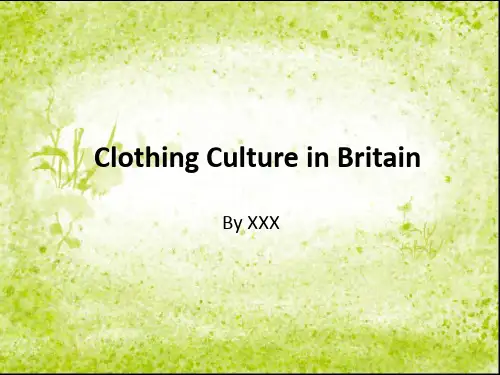

各个国家服饰文化英语作文Title: The Cultural Tapestry of National DressThe world is a vast canvas, each thread in its weave representing a unique culture, and among the most vivid threads are those that depict national dress. The attire of a nation serves not only as a marker of identity but also as an emblem of its history, values, and societal norms. In this essay, we will explore the rich tapestry of national dress across different countries, revealing the stories and significance woven into every garment.In Japan, the kimono is a graceful and elegant reminder of the country’s reverence for tradition. This formal garment, characterized by its straight lines and wide sleeves, often features intricate patterns that narrate tales of seasonal change, flora, and fauna. The act of wearing a kimono encapsulates the Japanese philosophy of harmony, simplicity, and a deep connection to nature.Traversing the globe to Africa, the diversity of traditional clothing mirrors the continent's vast cultural mosaic. In West Africa, the vibrant and colorful garments such as the Dashikifrom Nigeria or the Grand Boubou from Senegal and Mali, tell stories of craftsmanship passed down through generations. These attires, often adorned with elaborate embroidery and symbolic patterns, reflect the social status and ethnic identity of the wearer.Moving to the opposite side of the spectrum, we find the crisply tailored suits and conservative dresses of Britain. The United Kingdom’s national dress reflects the country’s history of propriety, class structure, and an understated sense of elegance. Tweeds and woolens, particularly in earthy tones, showcase the cool and sometimes damp climate of the region while maintaining a steadfast commitment to tradition and a quietly authoritative presence on the global stage.In India, where festivals paint the calendar with vibrant hues, the national dress known as the sari epitomizes both elegance and practicality. This unstitched piece of cloth, draped in various styles across regions, comes alive with extravagant colors and patterns. It is not merely a garment but a cultural icon signifying femininity, grace, and resilience.Australian aboriginal art finds expression on modern attire, blending the ancient with the contemporary. Traditional cloaks,adorned with dreamtime stories through intricate dot paintings, connect the past to the present, while also serving as a political statement about sovereignty and cultural survival.In Scandinavian countries like Sweden, simplicity and functionality reign supreme. Garments are designed to endure the harsh winters, with thick fabrics and thoughtful constructions that ensure warmth without sacrificing style. Clothes often come in neutral tones, reflecting the minimalist aesthetic that is harmoniously attuned to the long dark nights and white landscapes of the north.As we journey through these diverse expressions of national dress, it becomes evident that clothes are more than mere fabric; they are the skin we wear to communicate who we are to the world. They speak of our ancestors' wisdom, our community's values, and our personal identity. Each garment, like a word on a page, contributes to the story of our human tapestry – a tale of diversity, resilience, and beauty.In conclusion, national dress is a testament to the intricate interweaving of culture, history, and identity within the fabric of global society. As keepers of our heritage and creators of our future, it is our role to appreciate and preserve these distinctiveexpressions, allowing the narrative of national dress to continue unfolding, one thread at a time.。
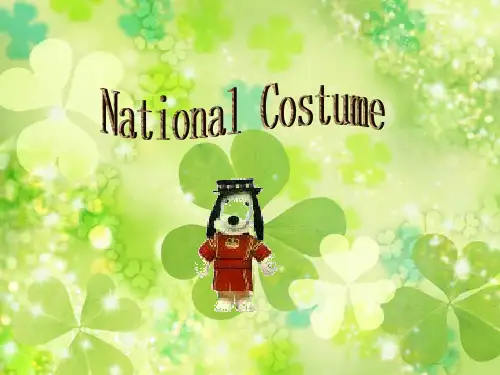
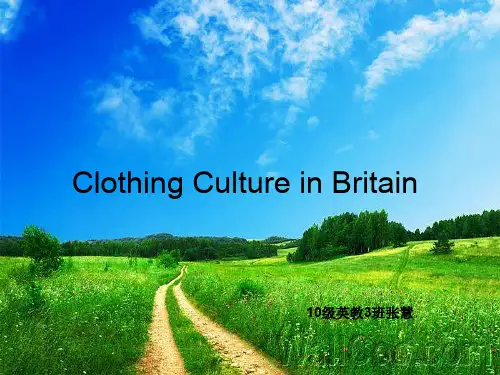
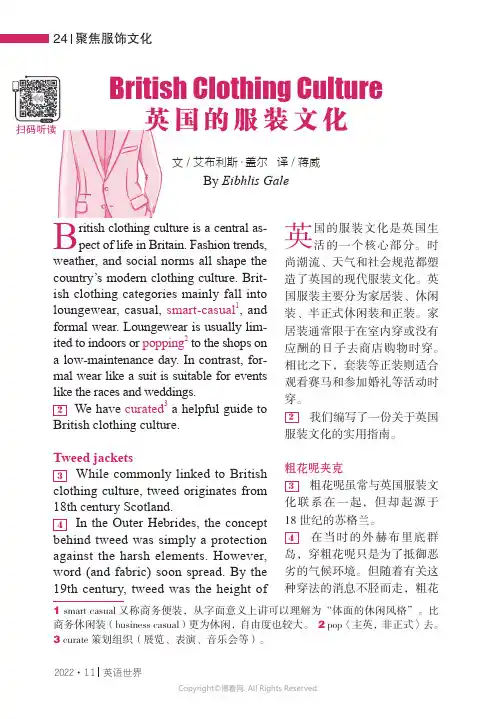
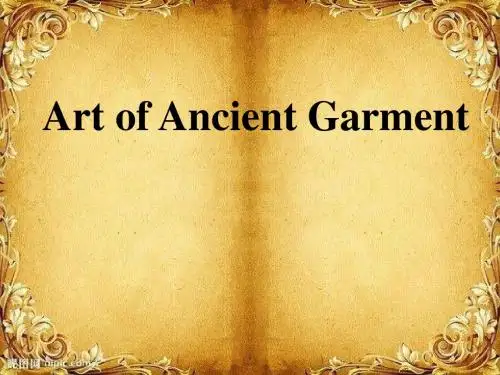
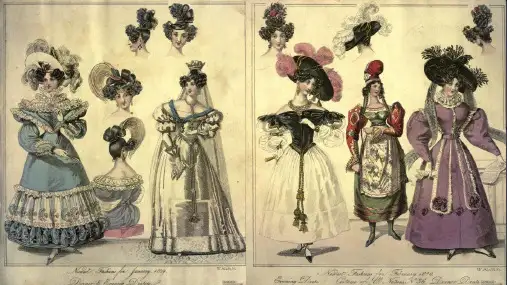
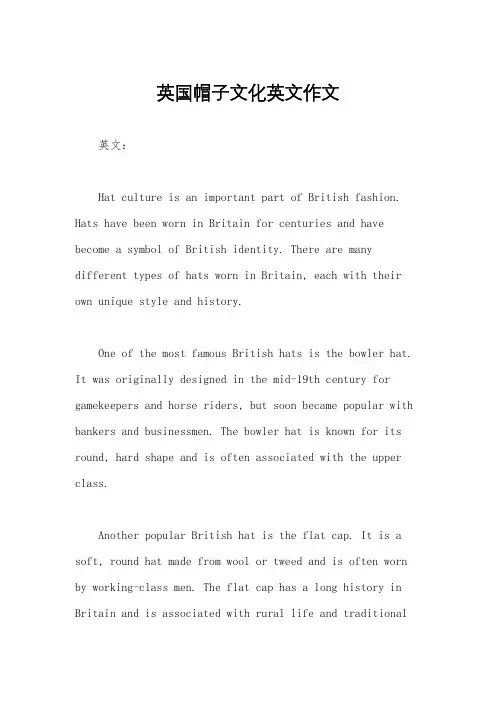
英国帽子文化英文作文英文:Hat culture is an important part of British fashion. Hats have been worn in Britain for centuries and have become a symbol of British identity. There are many different types of hats worn in Britain, each with their own unique style and history.One of the most famous British hats is the bowler hat. It was originally designed in the mid-19th century for gamekeepers and horse riders, but soon became popular with bankers and businessmen. The bowler hat is known for its round, hard shape and is often associated with the upper class.Another popular British hat is the flat cap. It is a soft, round hat made from wool or tweed and is often worn by working-class men. The flat cap has a long history in Britain and is associated with rural life and traditionalvalues.In addition to these hats, there are many other styles worn in Britain, such as the top hat, the fedora, and the beanie. Each style has its own unique history and cultural significance.Hat culture is not just limited to fashion, it also plays a role in British social etiquette. For example, it is considered rude to wear a hat indoors, especially in formal settings. Hats are also often worn at weddings and other special occasions.Overall, hats are an important part of British culture and fashion. They have a rich history and continue to be worn today as a symbol of British identity and style.中文:帽子文化是英国时尚的重要组成部分。
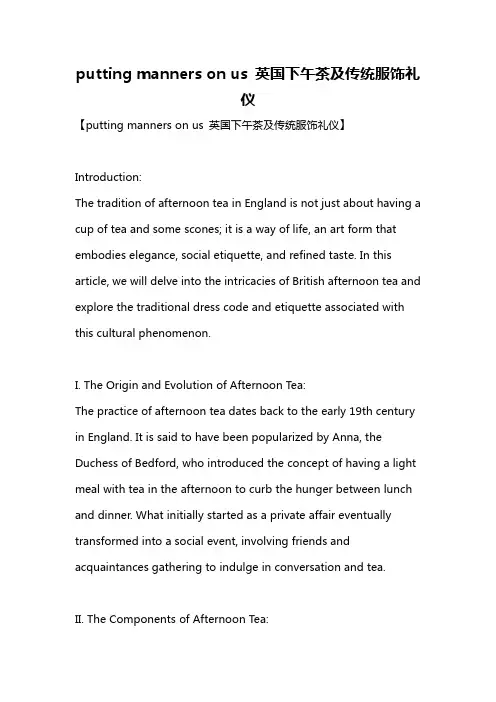
putting manners on us 英国下午茶及传统服饰礼仪【putting manners on us 英国下午茶及传统服饰礼仪】Introduction:The tradition of afternoon tea in England is not just about having a cup of tea and some scones; it is a way of life, an art form that embodies elegance, social etiquette, and refined taste. In this article, we will delve into the intricacies of British afternoon tea and explore the traditional dress code and etiquette associated with this cultural phenomenon.I. The Origin and Evolution of Afternoon Tea:The practice of afternoon tea dates back to the early 19th century in England. It is said to have been popularized by Anna, the Duchess of Bedford, who introduced the concept of having a light meal with tea in the afternoon to curb the hunger between lunch and dinner. What initially started as a private affair eventually transformed into a social event, involving friends and acquaintances gathering to indulge in conversation and tea.II. The Components of Afternoon Tea:1. The Tea: Traditionally, afternoon tea is served with a selection of loose-leaf teas, including popular choices such as Earl Grey, Assam, and Darjeeling. Black teas are most commonly preferred, as they complement the flavors of the savory and sweet items served.2. The Food: Afternoon tea comes with a tiered stand of delectable treats. The bottom tier usually consists of finger sandwiches with various fillings like cucumber and cream cheese, smoked salmon, and egg salad. The middle tier is dedicated to freshly baked scones served with clotted cream and strawberry jam. The top tier features an assortment of delicate pastries, cakes, and biscuits.III. Dress Code for Afternoon Tea:1. Daytime Dress: English afternoon tea is traditionally enjoyed in the afternoon, so it is recommended to dress smartly but not overly formal. Men can opt for tailored trousers, a shirt, and a blazer or a sports jacket. Women can wear day dresses, skirts, or tailored trousers with a blouse or a smart top.2. Hats and Fascinators: Wearing hats or fascinators is a popular choice for women attending formal afternoon tea events. These headpieces add a touch of elegance and can be matched with theoverall outfit.IV. Etiquette and Manners:1. Seating Arrangement: The host or hostess usually arranges the seating, ensuring that guests are seated in a manner that allows for easy conversation and interaction.2. Utensil Usage: When using a tea service, it is essential to remember the appropriate use of utensils. The teaspoon is used for stirring tea, while the cake fork is used for eating pastries and cakes. The teacup should be held by the handle with the pinky finger not extended.3. Scone Etiquette: Splitting the scone in half with your hands is the traditional way of serving it. Then, small amounts of clotted cream and jam are spread on each half. Once topped, the scone can be eaten with fingers, beginning from the bottom and working upwards.4. Tea Etiquette: Milk or lemon? The decision to add milk or lemon to tea is a matter of personal preference. However, if you choose to add milk, it is proper etiquette to pour the tea first and then addmilk. Adding milk before the tea is considered impolite.Conclusion:Indulging in the elegance and sophistication of British afternoon tea is not just about savoring the flavors of tea and treats. It also involves honoring traditional dress code and etiquette, which adds an air of refinement to the experience. So, the next time you attend an afternoon tea event in the UK, remember to dress smartly, mind your table manners, and partake in this delightful cultural tradition.。
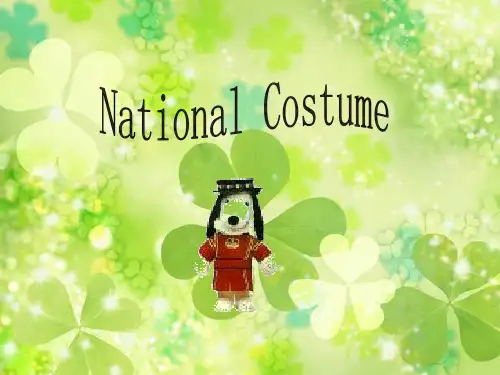
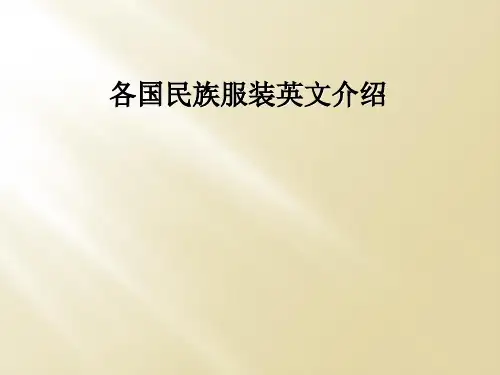
English Renaissance DressEnglish Renaissance dress style was quite heavily influenced by the French, and to a lesser (较少的)degree the Spanish. Indeed some scholars debate whether there was an actual English Renaissance, but they do admit to an “artistic flowering” during the reigns of the Tudor monarchs. The English Renaissance period was characterized by achievements in literature and music, rather than the visual arts of painting and architecture that was developing in Italy and France. Even though some elements of English Renaissance dress were borrowed from other countries, they did make variations and improvements upon them. One example is the ruff(环状领), thissmall ruffle around the neck and sleeves of a man's linen (亚麻布)shirt, which could vary greatly in its ornateness(华丽), became a favorite of English gentlemen. The ruff had originally been introduced in Spain by a noblewoman wishing to hide a blemish on her neck.During the English Renaissance, many garments(衣服)of the same style were worn by both the upper and the lower classes. However, the type, quality and especially color, of the fabric(织物)used for these clothes varied greatly between the classes. To the rich, fashion was very important as a symbol of their wealth and influence; to the poor, however, their concerns were that a garment be practical, and above all durable(持久耐用的). All classes used wool or linen(亚麻布)for shirts and underwear, but of vastly different quality. Only the extremely wealthy could afford cotton or silk under garments. These were often embroidered(绣花的)with gold, silver or silk thread(线).Fabrics used in English Renaissance clothing were colored almost exclusively with vegetables dyes(染料). The most common being madder for red, woad(靛蓝)for blue, and walnut (茶色)for brown.In order to create other colors and shades, a chemical, known as a mordant, was needed. For instance, alum(明矾)used with the weld(焊接)plant would produce yellow, whereas iron or tin used with weld would result in shades of green. The most expensive dyes to produce were bright red and black. Therefore, only the truly wealthy wore jet(深黑色)black clothing, and scarlet(绯红色), during the English Renaissance, referred not to a color, but to an extremely expensive fine grade of wool. Because dyeing was expensive, the clothing of the poorer classes was generally limited to uncolored linen and brown wool.Laws passed during the English Renaissance, known as Sumptuary (规范的)Laws, were supposed to help curb(抑制)some of the growing extravagance (铺张浪费的)centering around clothing, but they also further enforced and emphasized the differences between the classes. Only members of the royal family could wear “fur of the black genet(麝猫)”. A person must be at least a viscount(子爵), in order to wear sable(黑貂皮), and a Knight of the Garter to wear blue or crimson velvet(深红色天鹅绒).Howards' Renaissance Dress is committed to bringing you a variety of Renaissance, medieval (中世纪的)and gothic(哥特式小说风格的)clothing and accessories(配件), ranging from peasant wear to more noble dress. Most of our garments for men and women are available in plus-sizes. As you browse our pages for gowns(长袍), breeches, tunics, vests, doublets, and much more; we hope to entertain you with a little English Renaissance history along the way. Thank you for visiting with us, and we hope you will come back often!!Mens English Renaissance DressThe splendor (光辉)of the English Renaissance costume for men, wasnowhere more evident than in an account of the meeting between Henry VIII and Francis I of France. Henry is said to have worn adoublet(男子紧上衣)made of cloth of gold, a rose-colored velvet(天鹅绒)vest, a collar made of alternating rows of rubies (红宝石)and pearls(珍珠), the order of Saint George, on an embroidered(绣花的)velvet ribbon(绸带), was draped around his neck. The boots he wore were of the softest yellow leather; and his roll-brim black velvet hat was encrusted with a band of diamonds, rubies, emeralds, and pearls, and trimmed with a curling long white feather. The middle portrait is of Henry's hated rival, Francis I.One style of English Renaissance dress for the wealthy or noble man began with a plain or plaited(编制的)linen(亚麻的)shirt accented(强调)at the neck by a small ruffle(花边)or ruff. At the wrist(手腕), the sleeve was adorned(装饰)with a similar ruff. Over this was worn a close-fitting square cut vest. Atop the vest, a tunic(短上衣)ordoublet(紧上衣), that was slashed(斜线)and reached nearly to the knee. The V-shaped opening of the tunic revealed the shirt and vest beneath. An example of this style can still be seen today in the uniforms of the "beef-eater" guards at the Tower of London. Beneath the doublet, the trunks(运动裤)were very full, slashed and puffed(夸张). The hose(长筒袜), which were of the finest wool, or in the case of royalty silk, were attached to the trunks with jeweled bands. Completing the ensemble was a very full knee-length outer garment made from velvet or cloth of gold. It was most often trimmed with a turnover fur collar, which made the width of the shoulders appear very broad. Wide elbow-length sleeves were encircled with deep fur bands. One might have several pairs of sleeves that could be laced on to the garment, depending upon the function the wearer wasattending. For the house or ballroom, the gentleman would wear a similar garment made of lighter-weight materials. The portraits of Henry VIII above, depict him wearing this style of English Renaissance dress.Womens English Renaissance DressWomen's dress, during the early years of the English Renaissance was in a definite state of evolution; drawing upon recent trends developing in Italy and Spain. The bodice, or waist, which was actually more like a corset, was lengthened and came to a dramatic point in the front; thus drawing in the waistline in a decidedly unnatural manner. The portrait on the left, of Lady Eleanor Herbert, is an excellent example of the extremely elongated waist. The neckline was generally square-cut, and decorated with a stiff embroidered inset, or with the recent Italian invention, lace. Attached to the bodice by laces, the narrow sleeves were adorned at the wrist with elaborate spills of lace, or bands of fur.Skirts worn by English Renaissance women were very full, and were supported by an under garment known as a farthingale; which consisted of a frame of hoops made from wood, whalebone, or even iron covered with a petticoat of fine linen. The farthingale was lifted up and supported around the waist by a coarse linen band referred to as the bum-roll. After about 1530, another under garment, the crinoline, appeared in Renaissance England. Originally developed in Spain, Queen Claude of France, who at one time had been served by the very young Anne Boleyn as lady-in-waiting, was responsible for introducing the crinoline to English ladies of the court. The hoops of the English crinoline became so large that edicts were passed to ban the wearing of them. Most ladies, however, ignored these bans and continued to wear crinolines, even though they were uncomfortable and inconvenient. The center portrait of Queen Anne, wife of James I, shows the exaggeration of the English crinoline.English Renaissance ladies usually completed their dress with a surcoat. This tight-waisted outer garment was open in front, in order to reveal the elaborate design and decorations of the skirt underneath. The sleeves, which were often floor-length, widened and flowed down from the shoulders, ending with fur edging. The surcoat was sometimes lined with fur that overlapped and trimmed the edges of its skirt. The portrait on the right is of Frances Sydney, Countess of Sussex, wearing just such a surcoat. The garment was most oftenmade of velvet or satin, but the more elaborate ones were made from embroidered silver tissue, or cloth of gold.Childrens English Renaissance DressChildren's English Renaissance dress generally followed the same style, and used the same materials, as the adults of the class the child was born into. All children wore swaddling bands until they were six to twelve months old; the only difference being the fabric of the bands. Most peasant infants were swaddled in bands torn or cut from cast-off clothing from their siblings or parents, that had become too worn to be mended or cut down for use by another family member. Children of the upper-classes and the nobility had their bands made from the finest, softest linen, and sometimes even silk. Parents of the time thought the swaddling bands would help the child's limbs to grow straight; they believed that it was not good for so young a child to be free to kick its legs, and flail its arms.The next stage in children's English Renaissance dress, was the tunic or gown. Peasant children often wore tunics handed down from siblings, or cut down from the tunics of older siblings or parents. This garment was most often made from a coarse, uncolored linen. Children of the upper-classes wore, what we would think of today as a gown. It was often made from fine fabrics, such as the softest wools, linens, and velvets. Although the fabrics might have varied, the purpose of the poor child's tunic and the wealthy child's gown was the same; to allow the child freedom of movement to begin crawling. English Renaissance dress for boys and girls was much the same until the boy was deemed ready to be "breeched". At this time, the boy had what was known as a "breeching party", and was given his first pair of breeches, along with other items of male attire. This ceremony took place whenever the child's parents and nurse decided the time was right; so a boy might be "breeched" as young as three, or as old as seven. A fine example of a young boy in a gown is depicted in the middle portrait above. It is of Lady Katherine Grey and her son; not her daughter as one might think from the dress the child is wearing. The sumptuousness of dress for English Renaissance children of the nobility can be seen above. The portrait on the left is Edward, Prince of Wales, later Edward VI. He looks very much a miniature version of his father, Henry VIII. The portrait on the right is of Arabella Stuart, who in later life became an important noblewoman of the English Renaissance.。
小学英语人教PEP新版三年级上册英国的着装文化在英国,民族服饰很有特点。
首先是帽子,其中最突出的就是英国绅士的圆顶硬礼帽——“波乐帽”(bowler hat),它是一种硬胎圆顶呢帽,通常是黑色。
传统上英国要人、名流显贵都要戴上这种礼帽,文艺作品中一提到B.H,读者可以立即联想到一位英国绅士。
现在在各大城市的大街上,这种波乐帽已不多见,但并未消失。
其次是英国人的各种传统的工作服装和服饰,包括:法院开庭时法官穿的黑袍、戴的假发,教堂礼拜时牧师所披的长袍,历届国会开会时女王所穿的白色长裙礼服、戴的王冠(其间坐在前排的“司法贵族”穿戴黑袍假发,“宗教贵族”着翻领红袍),还有王宫卫士所穿的鲜艳的短外衣、黄束腰、高筒黑皮帽,伦敦塔楼卫士的黑帽、黑衣,近卫骑士的黑衣、白马裤、黑长靴等等。
再次苏格兰人视苏格兰短裙为“正装”,在婚礼或者其他较为正式的场合才穿。
直到现在,苏格兰的军队还把苏格兰短裙当成制服。
黑色的呢子上装,白色的衬衫,花格呢裙,羊毛袜,再配上同样花型的格呢披肩和有兽皮装饰的系于腰间的酒壶,一个标准的苏格兰男子的形象就跃然眼前。
在英语中,苏格兰短裙被称为“kilt”,这是地道的苏格兰语。
关于此短裙的起源,英格兰人和苏格兰人一直有争论。
有一种说法是:一个名叫汤姆·罗琳逊的英格兰人最早倡导穿苏格兰短裙。
据记载,1715年,英国政府采取开放政策,允许英格兰、苏格兰两地的人们互通贸易,汤姆·罗琳逊便是从中受益、北上淘金的商人之一。
他在苏格兰北部开了家木炭画加工厂,苏格兰短裙就是他在工人中推广的工作服。
传统的苏格兰服饰“kilt”,原本包括宽大的披肩,披肩和短裙连成一体,在砍树时很不方便,汤姆·罗琳逊便向裁缝提出,将“kilt”一剪为二,苏格兰短裙由此诞生。
但是,也有记载表明,早在1624年,苏格兰军队就将苏格兰短裙作为军队的制服了。
“穿苏格兰短裙不穿内裤”的说法也一直在流传。
一种解释是:只有在跳舞的时候才需要穿内裤;如果穿有衬里的苏格兰裙,内裤似乎就成了累赘;穿没有衬里的毛料苏格兰裙,内裤就不可缺少;是否需要穿内裤取决于天气、个人习惯以及要出席的场合等。